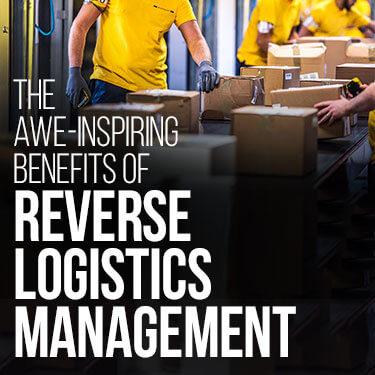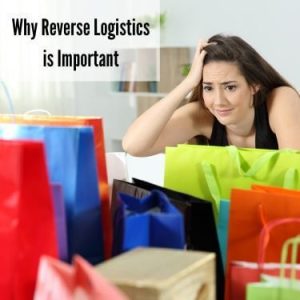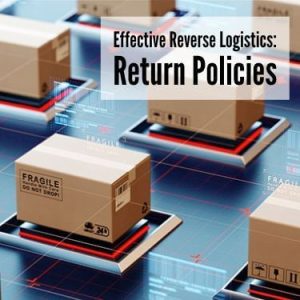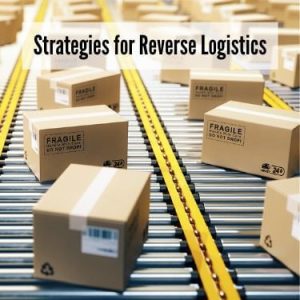
 Copy URL to Clipboard
Copy URL to Clipboard
There are numerous benefits of reverse logistics management. However, most people don’t really understand what this service is despite using it without realizing it. Reverse logistics management is used frequently and it benefits manufacturers the most.
The benefits of reverse logistics management come into play the most when a customer returns a manufacturer's product. By using reverse logistics services, manufacturers are able to:
Table of Contents
Before getting into the details of reverse logistics management, it’s important to understand what exactly reverse logistics is. Simply put, reverse logistics is used to move goods from customers back to the manufacturer. It’s essentially the normal logistics process but in reverse.
In many cases, the flow of reverse logistics services starts with the return of goods sold. There are many reasons a customer might return goods. The product doesn’t match the description, or it arrived after it was needed. In other cases, the customer might not like the product they received.
While many different businesses utilize reverse logistics, it is an especially important part of ecommerce fulfillment. In fact, many consumers review an online retailer’s returns process before placing an order. Companies that don’t have streamlined return policies and reverse logistics procedures lose business.

When you’re a manufacturer, you want your customers to always be satisfied with the products they buy from you. That said, returned goods are just part of the business. Fortunately, you can use reverse logistics to your advantage with these benefits.
When your business has a good return management system in place, you're more likely to maintain a relationship with your customers. By using reverse logistics, you're essentially putting in place your own return policy. This lets customers know that even when they’re dissatisfied, you still care about them and their concerns.
If a customer is dissatisfied with the product they’ve returned because it was defective, you now have an opportunity to correct the problem. This means that you can provide a refund, fix the damaged product, or provide the customer with a replacement. Providing this service will also contribute to you improving customer satisfaction and relations.
If you’ve determined that the goods that have been returned to you are still in great shape, you can always resell them. This is perfect for returned goods that have not been discontinued. You could even try reselling it as used for a cheaper price.
For returned goods that are not salvageable, you can recycle them instead. Recycling the goods benefits your manufacturing operation and the environment. When you recycle returned goods, you improve the sustainability of your operations.
As for the environment, recycling is beneficial because products and materials the items are made out of will be repurposed into something else. According to reports, about 5 billion pounds of returned items are trashed each year and much of the U.S.’s garbage ends up in landfills.
Reverse logistics can have a huge impact on the environment because it allows manufacturers to productively use returned goods. A solid reverse logistics process can increase your business’s sustainability and help you remain environmentally friendly.
The table below shows how many goods are wasted each year and how companies are suffering by not using reverse logistics management.
|
Amount Of Returns In Landfills |
6 Billion Pounds |
|
Amount Of Retailers That Use Return Policies |
23 Percent |
|
Amount Of Retailers Whose Profit Margins Are Affected by Returns |
44 Percent |
|
Amount Of Retailers Who Quantify Their Returns |
30 Percent |
Reverse logistics management gives you the opportunity to continue to make money and save on costs. For example, reselling the goods that have been returned to you will allow you to make back the money you lost when you issued a refund to the customer returning the product.
Repairing the returned goods will save you money (except for the costs of shipping the product again). You also have the opportunity to repurpose the materials from returned products for making newer ones. This saves you a little bit of money that would normally be spent on buying new materials for your products.
Reverse logistics should work seamlessly and efficiently, just like traditional warehouse logistics. Reverse logistics is about cutting costs, increasing efficiency and optimizing the value of returned items. Reverse logistics can cost more than forwarding logistics.
Labor and shipping costs can increase the price. In many cases, returned packages are opened by hand, examined, sorted, repaired, repackaged and redistributed. Allowing a logistics partner, like R+L Global Logistics to meet your fulfillment, distribution and reverse logistics needs can save your business time and money.
There are ways you can reduce how returns nibble away at your warehousing and operations costs. Returns might lead to costs, like customer service labor costs, transportation costs, transaction costs and shipping costs.
However, an implemented reverse logistics process can help cut these costs through automation and efficiency. Outsourcing reverse logistics to a 3PL partner like R+L Global Logistics can also help reduce distribution and warehousing costs. R+L Global is skilled and knowledgeable when it comes to processing returns of unwanted, broken/damaged or even recalled products.

There are a number of things that could happen to your product after it is returned. Many of these options depend on the condition of the product.
Here are a few typical final destinations for a product after it is returned:
Returns that don’t meet the above qualifications will have to be disposed of and considered a loss. Some locations have laws about how the disposal of certain goods is handled. Check local regulations before disposing of any items.

Implementing a reverse logistics process doesn’t have to be rocket science. When you set up policies and procedures for reverse logistics, it’s important to keep both your business and customers in mind. Here are some ideas for effective reverse logistics for your ecommerce business.
One way you can prevent returns before they happen is by confirming your customer’s address. This can help ensure delivery the first time. You can do things the old-fashioned way by calling your customers after they place an order to confirm their address. You can take advantage of technology and integrate an API to check the address into your enterprise system or ecommerce website
When you come up with a returns policy for your business, it is wise to keep both your business and your customers’ needs in mind. It might be challenging to find a balance, but it can be done.
You don’t want returns to be a hassle for your customers. One way you can simplify the returns process for both you and your customers is by prepping for returns. Returns forms can allow the customer to indicate why they are returning the product. This can help you determine how to process the return.
Providing your customers with return labels can help make sure the returned items make it back to your warehouse. You might also include a barcode on the label. The barcode can help you ensure your warehouse knows how to process the return when it arrives.
If your business is willing or able, you might consider paying for return postage for returns. This can help your business stay competitive, as many businesses offer free return shipping. You can also deduct the cost of return shipping from the credit issued to the customer. This can make the returns process easier for customers.

Now that you understand reverse logistics benefits and return policies, you should consider implementing a reverse logistics process that can benefit your business. Growth in eCommerce and shifting customer expectations require businesses to improve the efficiency of their reverse logistics operations.
Many retailers, both eCommerce and brick and mortar, are adopting strategies to improve reverse logistics. Here are a few strategies some retailers are using to improve reverse logistics services.
Many retailers and ecommerce companies let third-party logistics (3PL) partners process, sort and even resell/dispose of returned products. In many cases, these partners can perform reverse logistics services more cost-effectively than internal handling. Working with a partner who can process returns can allow you to focus on your business.
Many businesses and 3PLs use data and technology to streamline their reverse logistics processes. This technology and information can be used to keep an eye on products at 3PL warehouses, troubleshoot and repair returned items. In some cases, companies can even use data and tech to let customers troubleshoot at home. Hardware can be sent to the customer’s home to fix the issue and prevent another cog in the returns process.
Additionally, data can be useful in strategizing reverse logistics. You can track things like volume of returns, condition of products returned and the reason for the return. This data can help you predict and prepare for the flow of reverse logistics and the volume of coming returns.
When dealing with a flood of returns, you need to strategize. Using the data you gather can help you create more efficient policies. Some businesses accept all kinds of returns, no questions asked. Others, like Amazon, will shut down a user’s account if they make too many returns.
Some companies have policies in place that allow them to ship out new items rather than accepting a return of a broken item. You can analyze return volume data to help create more efficient policies that allow your company to handle returns in a way that best fits your needs and your customers’ needs.
More and more consumers are turning to ecommerce businesses to get the products they need. This means transportation costs are rising. Transporting and processing returns for large items like furniture, equipment and machinery and large electronics can be costly for manufacturers and retailers.
One strategy retailers and manufacturers are using are combining transportation services. Pickup and delivery can occur on the same trip. Combining services can increase efficiency.
Some companies are also opening centralized return centers. These centers can help improve efficiency in the logistics life cycle. Having all returns centralized and processed under one roof can make sure operations are optimized.
When thinking about reverse logistics, it is wise to consider your vendor agreements. Instead of looking at just price, also look at the vendor’s return policy. Manufacturers might not like processing returns, but neither do retailers. Taking a look at your vendor agreements can help you determine what to do with returned items.
Looking at vendor agreements is especially important if you are selling consumer electronics. Some electronics, including smartphones, have return rates of up to 12 percent according to the Consumer Electronics Association.
Contact our team today if you need any help figuring these strategies out.
R+L Global Logistics knows that returns come in all shapes and sizes. Reverse logistics and reverse fulfillment services can help your business keep a leg up on the competition. Reverse logistics services include:
Need a solution for reverse logistics? Let R+L Global Logistics help. You’ll find a number of reasons why working with R+L Global is a good idea for your reverse and other logistics needs, including:
With so much to offer, why don’t you reach out to R+L Global today? Contact us, chat with us or give us a call. We understand what is reverse logistics and are able to help your business take advantage of this important process.
